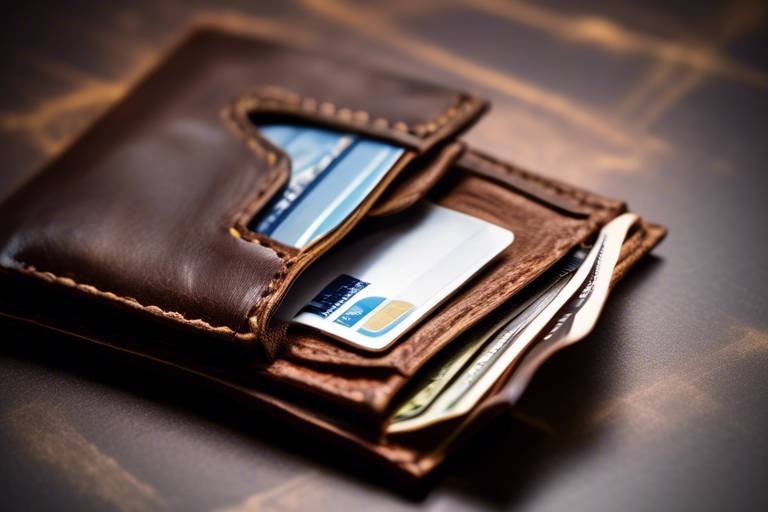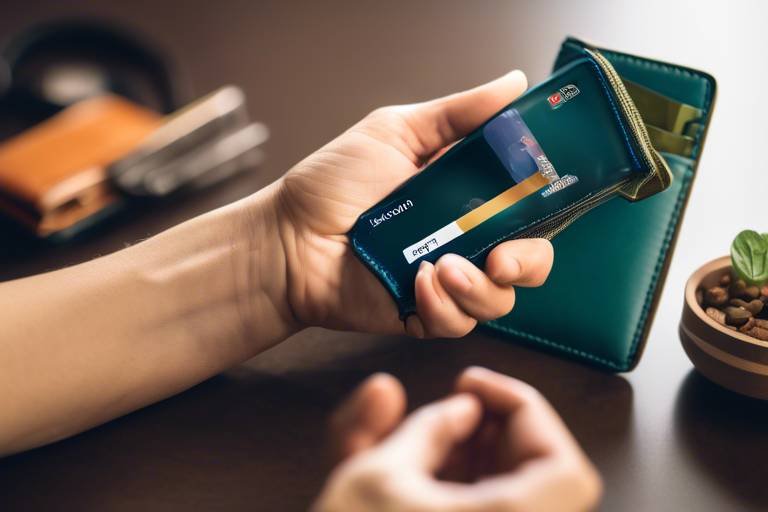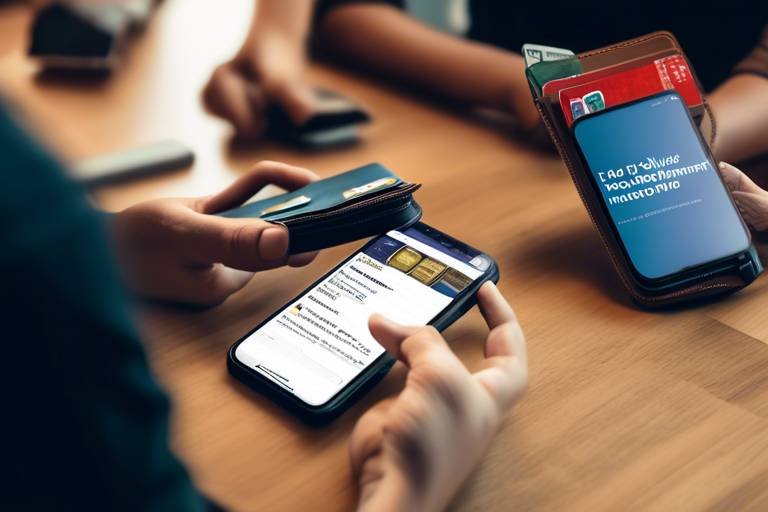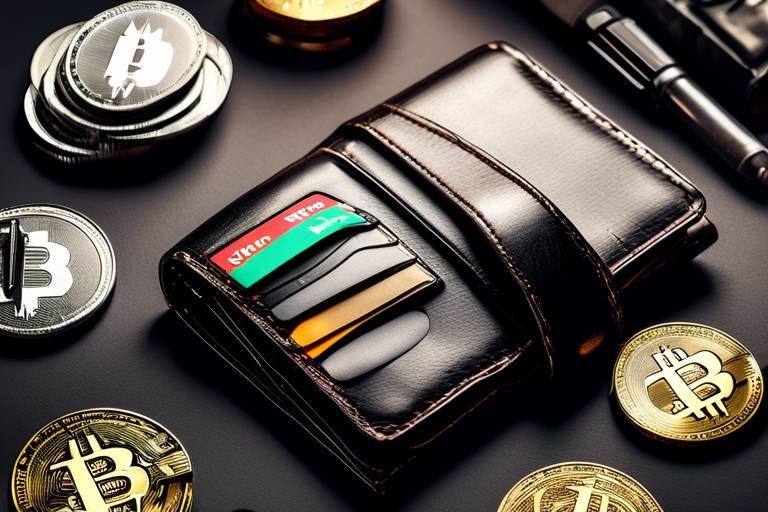Understanding Wallet Integration with Other Financial Services
The financial landscape is undergoing a seismic shift, and at the heart of this transformation lies the concept of wallet integration. As we delve into this intricate relationship between digital wallets and various financial services, it's essential to recognize how these integrations are not just reshaping consumer behavior but are also redefining the very essence of financial transactions. Imagine a world where your wallet is not merely a physical object but a gateway to a plethora of services that enhance your financial well-being. This article explores the multifaceted benefits, challenges, and future trends associated with wallet integration, revealing how it is changing the way we interact with money.
Digital wallets have gained immense popularity, transforming how consumers manage their finances. In recent years, we've witnessed a remarkable surge in the adoption of these virtual payment solutions. The rise of smartphones, coupled with advancements in technology, has made it easier than ever for individuals to carry their financial assets in their pockets. No longer do we need to fumble through our bags for cash or cards; instead, with a simple tap on our screens, we can access a world of financial services. The factors driving this adoption are numerous, including the convenience of mobile payments, the growing trend of online shopping, and the increasing need for contactless transactions, especially in a post-pandemic world.
Integrating wallets with other financial services offers numerous advantages that are hard to overlook. One of the most significant benefits is the enhanced user experience. Imagine being able to pay for your groceries, transfer money to a friend, and manage your investments all from a single app. This seamless experience not only saves time but also fosters customer loyalty, as users are more likely to stick with services that make their lives easier. Additionally, wallet integration leads to streamlined transactions. Users can make payments across various platforms effortlessly, which is a game-changer in today's fast-paced world. The significance of this feature cannot be overstated; it improves transaction efficiency and speed, making financial interactions more fluid than ever.
A seamless integration of wallets with financial services leads to a more intuitive user experience. Consider this: when you can pay for your coffee and check your bank balance within the same app, it feels like magic! This convenience influences customer loyalty and satisfaction in the digital finance realm. Users are more likely to engage with platforms that provide a holistic financial experience, where everything they need is just a click away. The emotional connection formed through such ease of use cannot be underestimated; it transforms mundane transactions into enjoyable experiences.
Wallet integration simplifies transactions by allowing users to make payments across various platforms effortlessly. This part discusses the significance of this feature in improving transaction efficiency and speed. With a digital wallet, the days of waiting in long lines or dealing with cash are fading away. Instead, users can quickly complete transactions with just a few taps. This efficiency is particularly crucial in high-traffic environments like retail stores or restaurants, where time is of the essence.
Security is paramount in financial transactions. With the rise of digital wallets, enhancing security protocols is more critical than ever. Wallet integration often incorporates advanced security measures such as biometric authentication, encryption, and tokenization. These technologies work together to protect users from fraud and ensure safe transactions. By adopting these robust security measures, digital wallets can provide users with peace of mind, knowing that their financial information is safeguarded against potential threats.
Despite the benefits, integrating wallets with financial services presents challenges. Regulatory hurdles, technological limitations, and consumer trust must be addressed to ensure successful integration. For instance, navigating the complex landscape of financial regulations can be daunting for companies looking to implement wallet integration. Furthermore, not all consumers are comfortable with digital transactions, and building trust in these technologies is essential for widespread adoption.
Looking ahead, the integration of wallets with financial services is expected to evolve significantly. Emerging trends, such as advancements in technology and changing consumer preferences, are shaping the future landscape of digital finance. One such trend is the adoption of blockchain technology. This revolutionary technology has the potential to enhance security, transparency, and efficiency in financial transactions, making it a perfect match for wallet integration.
Blockchain technology is poised to revolutionize wallet integration. By providing a decentralized and secure method for recording transactions, it can enhance trust among users. Imagine a world where every transaction is transparent and immutable, reducing the risk of fraud and errors. This potential is driving interest in integrating blockchain with digital wallets, paving the way for a more secure financial ecosystem.
The use of AI in wallet integration can lead to personalized financial services. AI can analyze user behavior and preferences, allowing for tailored services that meet individual needs. For example, imagine receiving personalized offers based on your spending habits, or having your financial assistant suggest budgeting strategies. This level of personalization can significantly enhance user engagement and satisfaction, creating a more meaningful connection between consumers and their financial services.
- What is wallet integration? Wallet integration refers to the process of connecting digital wallets with various financial services, enabling seamless transactions and enhanced user experiences.
- What are the benefits of using a digital wallet? Benefits include convenience, improved security, and streamlined transactions across multiple platforms.
- How does blockchain technology improve wallet integration? Blockchain enhances security and transparency, making transactions more trustworthy and efficient.
- What challenges exist in wallet integration? Challenges include regulatory hurdles, technological limitations, and the need to build consumer trust.

The Rise of Digital Wallets
In recent years, digital wallets have surged in popularity, reshaping the financial landscape as we know it. Gone are the days when carrying cash and coins was the norm; today, people are embracing the convenience and efficiency that comes with managing their finances through their smartphones. But what exactly has fueled this remarkable growth? Let's dive into the factors that have contributed to the rise of digital wallets.
First and foremost, the advent of smartphone technology has played a pivotal role. With the majority of the global population now owning smartphones, the accessibility of digital wallets has skyrocketed. Consumers can easily download wallet apps and link them to their bank accounts or credit cards, enabling them to make transactions with just a few taps on their screens. This convenience is a game-changer, especially in a fast-paced world where time is of the essence.
Another significant factor is the increased internet penetration across the globe. As more people gain access to the internet, the ability to use digital wallets has expanded beyond urban centers to rural areas. This connectivity has opened new avenues for financial inclusion, allowing individuals who previously lacked access to traditional banking services to engage in digital transactions.
Moreover, the rise of e-commerce has created a perfect storm for digital wallets. As online shopping becomes more prevalent, consumers are looking for secure and efficient payment methods. Digital wallets provide a seamless checkout experience, reducing the friction often associated with entering card details on various websites. In fact, studies show that consumers are more likely to complete a purchase when they have the option to pay with a digital wallet.
Technological advancements also play a crucial role in this rise. Features such as contactless payments, QR codes, and biometric authentication have made digital wallets not only more user-friendly but also safer. The integration of these technologies enhances the overall user experience, making transactions quicker and more secure. For instance, the ability to simply tap a phone at a payment terminal has revolutionized how we think about transactions.
However, it's not just technology driving this trend; consumer behavior is evolving as well. People are increasingly valuing speed, convenience, and security in their financial transactions. Digital wallets cater to these needs, providing a platform that feels intuitive and modern. As younger generations—who are more tech-savvy—enter the market, their preference for digital solutions further accelerates the adoption of digital wallets.
In summary, the rise of digital wallets can be attributed to a combination of factors including technological advancements, increased internet access, the growth of e-commerce, and changing consumer preferences. As digital wallets continue to evolve, they are likely to become an integral part of our daily lives, paving the way for a cashless future. With all these exciting developments, one can't help but wonder: what will the next chapter in the evolution of digital wallets look like?

Benefits of Wallet Integration
Integrating digital wallets with various financial services brings a multitude of benefits that not only enhance the user experience but also streamline financial transactions. As we dive into this topic, you'll discover how these integrations are transforming the way we handle money in our daily lives. Imagine being able to manage all your financial activities from a single platform; this is the convenience that wallet integration offers. It creates a cohesive ecosystem where users can access banking, shopping, and payment services seamlessly.
One of the most significant advantages of wallet integration is the enhanced user experience. When wallets are integrated with financial services, customers can enjoy a more intuitive interface that simplifies their interactions. For instance, instead of juggling multiple apps or websites to complete a transaction, users can execute everything from their digital wallet. This convenience not only saves time but also fosters a sense of loyalty among customers who appreciate the ease of managing their finances in one place. It's like having a personal assistant that organizes your finances effortlessly!
Moreover, wallet integration leads to streamlined transactions. With the ability to make payments across various platforms, users can conduct transactions quickly and efficiently. This feature is especially important in today’s fast-paced world, where time is of the essence. Think about it: when you can complete a purchase with just a few taps on your phone, it eliminates the frustration of lengthy checkout processes. This speed and efficiency are crucial for businesses as well, as they can cater to customers' needs more effectively, ultimately boosting sales and customer satisfaction.
Another critical aspect is the improved security measures that come with wallet integration. In an age where cyber threats are rampant, security is a top priority for financial transactions. Integrated wallets often employ advanced security protocols, including encryption and multi-factor authentication, to protect users from fraud. This not only gives users peace of mind but also builds trust in the financial services they engage with. When consumers feel secure in their transactions, they are more likely to embrace digital wallets as a primary means of managing their finances.
In summary, the benefits of wallet integration are clear: enhanced user experience, streamlined transactions, and improved security measures all contribute to a more efficient and satisfying financial landscape. As we continue to embrace digital solutions, understanding these benefits helps us appreciate the evolving relationship between wallets and financial services.
- What is wallet integration? Wallet integration refers to the connection between digital wallets and various financial services, allowing users to manage payments and transactions seamlessly.
- How does wallet integration enhance security? Wallet integration enhances security through advanced measures such as encryption, multi-factor authentication, and real-time fraud monitoring.
- What are the benefits of using a digital wallet? Benefits include convenience, speed of transactions, enhanced security, and the ability to manage multiple financial services from one platform.

Enhanced User Experience
In the fast-paced world of digital finance, user experience (UX) is more than just a buzzword; it's a critical factor that can make or break a financial service. When it comes to wallet integration, a seamless user experience is paramount. Imagine walking into a store, grabbing your favorite items, and checking out without fumbling through your wallet or waiting in long lines. That’s the kind of convenience digital wallets provide when they're integrated with various financial services. This integration allows users to make transactions with just a few taps on their smartphones, which is not only time-saving but also enhances overall satisfaction.
One of the most significant aspects of enhanced user experience is the intuitive design that comes with integrated wallets. Users are no longer required to navigate through multiple apps or websites to complete transactions. Instead, everything is streamlined into one platform, making it easier for individuals to manage their finances. For instance, when purchasing an item online, a user can select their digital wallet as a payment method, complete the transaction, and even receive instant notifications about their spending—all without leaving the site. This level of convenience fosters a sense of loyalty and trust between consumers and financial service providers.
Furthermore, the integration of digital wallets with other financial services often includes features like real-time updates and personalized recommendations. For example, if a user frequently buys coffee, the wallet can suggest nearby cafes that offer discounts or loyalty points. This not only enhances the shopping experience but also encourages users to engage more with their wallets. By providing tailored suggestions based on spending habits, financial services can create a more personalized journey for each user.
Another key element to consider is the cross-platform functionality that integrated wallets offer. Whether you're using a smartphone, tablet, or desktop, the experience remains consistent. Users can start a transaction on one device and complete it on another without any hiccups. This flexibility is crucial in today's digital age, where consumers expect to have access to their financial information anytime, anywhere. It’s like having a personal assistant who knows your preferences and is ready to help you at a moment's notice.
To sum it up, the enhanced user experience brought by wallet integration is not just about ease of use; it's about creating a holistic financial ecosystem that caters to the modern consumer's needs. As technology continues to advance, we can expect even more innovations that will make managing finances not only easier but also more enjoyable. After all, who wouldn't want to handle their finances with the same ease as scrolling through their favorite social media feed?
- What is a digital wallet? A digital wallet is a virtual wallet that allows users to store and manage their payment information, making it easier to conduct transactions online and in-person.
- How does wallet integration improve user experience? Wallet integration simplifies the payment process, provides real-time updates, and offers personalized recommendations, making financial management more intuitive.
- Are digital wallets secure? Yes, most digital wallets use advanced security measures, including encryption and two-factor authentication, to protect users' financial information.
- Can I use my digital wallet across different platforms? Absolutely! Integrated wallets are designed to work seamlessly across various devices, ensuring a consistent user experience.

Streamlined Transactions
In today's fast-paced world, the need for efficiency in financial transactions cannot be overstated. Digital wallets have emerged as a game-changer, enabling users to make payments with just a few taps on their smartphones. This convenience is not merely a luxury; it has become a necessity for consumers who value their time. Imagine walking into a store, grabbing your items, and checking out without fumbling for cash or cards. This seamless process is what are all about.
One of the key features that enhance transaction efficiency is the ability to link multiple payment methods within a single digital wallet. Users can store credit cards, debit cards, and even cryptocurrencies, allowing them to choose their preferred payment method on the fly. This flexibility eliminates the need to carry multiple cards or cash, simplifying the payment process.
Moreover, the integration of wallets with various platforms—be it e-commerce sites, subscription services, or even peer-to-peer payment systems—has significantly reduced the friction associated with transactions. For instance, when purchasing an item online, users can complete their checkout in seconds, without the tedious process of entering card details repeatedly. This not only saves time but also enhances the overall shopping experience, making it more enjoyable and less stressful.
To illustrate the impact of streamlined transactions, consider the following table that compares traditional payment methods with digital wallets:
| Payment Method | Time to Complete Transaction | Convenience Level |
|---|---|---|
| Cash | Varies (can take longer due to change) | Low |
| Credit/Debit Card | 10-30 seconds | Medium |
| Digital Wallet | 5-10 seconds | High |
This table clearly demonstrates that digital wallets not only speed up transactions but also elevate the convenience factor to new heights. With just a few clicks, users can complete their purchases, making it an attractive option for those who are always on the go.
Furthermore, the integration of digital wallets with loyalty programs and promotional offers has added another layer of appeal. Users can automatically apply discounts or earn rewards points during their transactions, making the experience even more rewarding. This not only encourages customer loyalty but also drives repeat business, as consumers are more likely to return to a platform that offers them tangible benefits.
In conclusion, the evolution of digital wallets has paved the way for that cater to the demands of modern consumers. As technology continues to advance, we can expect even greater innovations that will enhance the speed and convenience of financial transactions, reshaping the way we handle money in our daily lives.
- What are digital wallets? Digital wallets are applications that allow users to store their payment information securely and make transactions using their smartphones or other devices.
- How do digital wallets enhance transaction speed? They store multiple payment methods, enabling quick selections at checkout, often reducing transaction times to just a few seconds.
- Are digital wallets secure? Yes, most digital wallets use advanced encryption and security protocols to protect user data and prevent fraud.
- Can I use a digital wallet for online and in-store purchases? Absolutely! Digital wallets can be used for both online transactions and in-store payments at participating retailers.

Improved Security Measures
In the realm of digital finance, security is not just a feature; it's a necessity. As consumers increasingly rely on digital wallets for their transactions, the integration of these wallets with various financial services has led to significant advancements in security measures. This evolution is crucial, considering the rising threats of cybercrime and data breaches that loom over the online financial landscape. With integrated wallets, financial institutions and service providers are prioritizing the implementation of robust security protocols designed to protect users and their sensitive information.
One of the most notable enhancements in security comes from the use of multi-factor authentication (MFA). This method requires users to provide two or more verification factors to gain access to their wallets, making it considerably harder for unauthorized individuals to breach accounts. For instance, a user might need to enter a password and then confirm their identity via a text message or an authentication app. This layered approach significantly increases the security of digital transactions and builds consumer trust.
Moreover, the integration of encryption technologies plays a pivotal role in protecting user data during transactions. Encryption transforms sensitive information into a code that can only be deciphered by authorized parties. This means that even if a hacker intercepts the data, they would be unable to read it without the proper decryption keys. Financial services that integrate wallets are now utilizing advanced encryption standards, ensuring that every transaction is safeguarded against potential threats.
Additionally, the implementation of real-time fraud detection systems has become a game-changer in enhancing security measures. These systems utilize machine learning algorithms to analyze transaction patterns and identify anomalies that may indicate fraudulent activity. For example, if a user typically makes small purchases and suddenly attempts to spend a large sum in a foreign country, the system can flag this transaction for review. This proactive approach not only protects users but also provides peace of mind, knowing that their financial activities are being monitored closely.
Another important aspect of improved security is the use of biometric authentication. Many digital wallets now offer fingerprint or facial recognition technology, allowing users to authorize transactions with a simple touch or glance. This not only streamlines the payment process but also adds an additional layer of security, as biometric data is unique to each individual and much harder to replicate than traditional passwords.
In conclusion, as digital wallets continue to integrate with various financial services, the focus on enhanced security measures becomes increasingly critical. By employing multi-factor authentication, encryption technologies, real-time fraud detection, and biometric authentication, these integrated systems are not only securing transactions but also fostering a sense of trust among users. In a world where digital threats are ever-evolving, such advancements are vital in ensuring that consumers feel safe and confident in their financial dealings.
- What are digital wallets? Digital wallets are electronic devices or online services that allow individuals to make electronic transactions, store payment information, and manage their finances securely.
- How do integrated wallets enhance security? Integrated wallets enhance security through multi-factor authentication, encryption, real-time fraud detection, and biometric authentication, ensuring that user data and transactions are protected.
- What is multi-factor authentication? Multi-factor authentication is a security process that requires users to provide two or more verification factors to access their accounts, making it harder for unauthorized access.
- Why is encryption important? Encryption is crucial as it protects sensitive data by converting it into a code, ensuring that even if data is intercepted, it remains unreadable without the proper keys.
- What role does AI play in wallet security? AI enhances wallet security by analyzing transaction patterns and identifying anomalies that may indicate fraudulent activity, allowing for real-time monitoring and intervention.

Challenges of Integration
While the integration of digital wallets with various financial services offers a plethora of benefits, it is not without its challenges. One of the most significant hurdles is navigating the complex web of regulatory requirements. Financial services are heavily regulated, and the introduction of new technologies like digital wallets raises questions about compliance. Different countries have varying regulations regarding data protection, anti-money laundering, and consumer rights, making it essential for wallet providers to stay informed and adaptable.
Moreover, technological limitations can pose a barrier to seamless integration. Not all financial institutions are equipped with the latest technology to support digital wallet functionalities. Legacy systems may not be compatible with modern applications, leading to inefficiencies and a lack of interoperability. This can frustrate users who expect a smooth and cohesive experience when using their wallets across different platforms.
Another critical aspect to consider is consumer trust. Many users are still hesitant to fully embrace digital wallets due to concerns over security and privacy. Despite advancements in security measures, incidents of data breaches and fraud can create skepticism. Building trust is essential for wallet providers, as they must reassure customers that their financial information is safe and that transactions are secure. This involves transparent communication about security protocols and swift responses to any potential threats.
Additionally, the rapid pace of technology can be both an advantage and a challenge. While innovation drives growth, it can also lead to fragmentation in the market. New players constantly emerge, each offering different features and services, which can confuse consumers. This saturation makes it difficult for any single wallet to establish itself as a market leader, as users may find themselves overwhelmed by choices.
In summary, the integration of digital wallets with financial services is a multifaceted endeavor that requires careful consideration of regulatory frameworks, technological capabilities, consumer trust, and market dynamics. Addressing these challenges is crucial for ensuring a successful and sustainable integration that benefits both consumers and financial institutions.
- What are the main challenges of integrating digital wallets with financial services?
The main challenges include regulatory compliance, technological limitations, consumer trust issues, and the rapid pace of technological change. - How can consumer trust be improved in digital wallet integration?
Consumer trust can be improved through transparent communication about security measures, prompt responses to security threats, and educating users about the benefits and safety of digital wallets. - Why is regulatory compliance a challenge for digital wallets?
Different countries have varying regulations regarding data protection and consumer rights, which makes it difficult for wallet providers to ensure compliance across different jurisdictions.

Future Trends in Wallet Integration
The world of digital finance is constantly evolving, and wallet integration with financial services is no exception. As we look to the future, several exciting trends are emerging that promise to reshape how we interact with our money. One of the most significant trends is the adoption of blockchain technology. This revolutionary technology is not just a buzzword; it has the potential to fundamentally change the landscape of financial transactions. By enhancing security, transparency, and efficiency, blockchain can provide a robust framework for wallet integration. Imagine a world where every transaction is recorded on a decentralized ledger, making it nearly impossible for fraud to occur. This level of security can significantly boost consumer confidence in digital wallets, encouraging more widespread adoption.
Another trend to watch is the increasing role of artificial intelligence (AI) in wallet integration. AI has the capability to analyze vast amounts of user data, allowing for a more personalized experience. For instance, AI can track spending habits and offer tailored financial advice, making users feel more in control of their finances. This personalization can lead to greater customer satisfaction and loyalty, as users are presented with services that genuinely meet their needs. Think of it like having a personal financial advisor in your pocket, available 24/7 to help you make the best decisions for your financial future.
Moreover, the integration of wallets with various financial services is expected to become more seamless. As technology advances, users will enjoy a more intuitive experience, where switching between services is as easy as a few taps on their smartphone. This level of convenience can significantly enhance user engagement and retention. For example, imagine paying for groceries, transferring money to a friend, and checking your investment portfolio all within a single app. This is the future of digital finance, where everything is interconnected, and users can manage their finances with unprecedented ease.
Another noteworthy trend is the growing emphasis on security measures. As digital wallets become more popular, so do the threats associated with them. Financial institutions and wallet providers are investing heavily in advanced security protocols, such as biometric authentication and end-to-end encryption. These measures are designed to protect users from potential fraud and identity theft. As consumers become more aware of these threats, their trust in digital wallets will likely increase, leading to broader adoption and integration.
Finally, we cannot overlook the impact of regulatory changes on wallet integration. Governments around the world are starting to recognize the importance of regulating digital financial services to protect consumers. As regulations evolve, wallet providers will need to adapt to comply with new standards. This could lead to more secure and reliable services, ultimately benefiting consumers. However, it also poses challenges, as companies must navigate the complex landscape of compliance while trying to innovate.
In summary, the future of wallet integration with financial services is bright and full of potential. With advancements in blockchain technology, AI personalization, seamless user experiences, enhanced security measures, and evolving regulations, we are on the cusp of a financial revolution. The question remains: are you ready to embrace these changes and take control of your financial future?
- What is wallet integration? Wallet integration refers to the connection between digital wallets and various financial services, allowing users to manage their finances more efficiently.
- How does blockchain enhance wallet security? Blockchain provides a decentralized ledger for transactions, making it nearly impossible for fraud to occur and ensuring transparency.
- Can AI personalize my financial services? Yes, AI can analyze your spending habits and preferences to offer tailored financial advice and services.
- What role do regulations play in wallet integration? Regulations are essential for protecting consumers and ensuring that wallet providers maintain high standards of security and reliability.

Adoption of Blockchain Technology
The is not just a trend; it's a transformative shift in how digital wallets integrate with financial services. Imagine a world where every transaction is not only secure but also transparent and efficient. That’s the promise blockchain holds. With its decentralized nature, blockchain eliminates the need for intermediaries, which can often slow down transactions and increase costs. Instead, it allows for peer-to-peer interactions that are both swift and secure.
One of the most significant advantages of blockchain is its ability to provide enhanced security. Traditional financial systems are vulnerable to hacks and fraud, but blockchain's cryptographic principles ensure that every transaction is recorded in a way that is nearly impossible to alter. Each transaction is linked to the previous one, creating an immutable chain of data. This not only protects users but also builds trust in the system. For instance, if a user makes a payment through a blockchain-integrated wallet, they can rest assured that their information is safe and that the transaction is verifiable.
Furthermore, blockchain technology can facilitate faster transactions. In a world accustomed to instant gratification, waiting days for a transaction to clear is becoming increasingly unacceptable. Blockchain enables transactions to be processed in real-time, meaning that users can send and receive funds almost instantly. This speed is particularly beneficial for international transactions, which traditionally involve multiple banks and can take several days to complete.
Another key aspect of blockchain adoption is transparency. With every transaction recorded on a public ledger, users can track their transactions and verify their legitimacy. This transparency can significantly reduce fraud and increase accountability among financial institutions. Imagine being able to see exactly where your money is going, and having the ability to verify that it’s being used as intended. This level of transparency fosters greater consumer confidence and encourages more people to embrace digital wallets.
However, the journey towards widespread blockchain adoption is not without its challenges. Regulatory hurdles remain a significant barrier, as governments and financial institutions grapple with how to integrate this new technology into existing frameworks. Additionally, the technological infrastructure required for blockchain is still developing, and not all financial services are equipped to implement it effectively. Despite these challenges, the potential benefits make it a worthwhile endeavor.
In conclusion, the represents a crucial step forward in the evolution of digital wallets and financial services. Its ability to enhance security, speed up transactions, and provide transparency creates a compelling case for integration. As more financial institutions recognize the value of blockchain, we can expect to see a growing number of digital wallets that leverage this technology, ultimately paving the way for a more efficient and secure financial landscape.
- What is blockchain technology?
Blockchain technology is a decentralized digital ledger that records transactions across many computers, ensuring that the recorded transactions cannot be altered retroactively.
- How does blockchain enhance security?
Blockchain uses cryptographic techniques to secure transactions, making it nearly impossible for unauthorized users to alter transaction data.
- Can blockchain technology speed up transactions?
Yes, blockchain can significantly reduce transaction times, enabling real-time processing without the need for intermediaries.
- What are the challenges of adopting blockchain?
Challenges include regulatory issues, technological limitations, and the need for widespread acceptance among users and financial institutions.

Personalization and AI Integration
The integration of Artificial Intelligence (AI) into digital wallets is a game-changer, ushering in an era of personalization that can significantly enhance user experience. Imagine walking into a store, and your wallet app instantly recognizes your preferences, suggesting products you might love or offering discounts tailored just for you. This is the power of AI in action, transforming a simple transaction into a highly personalized experience that feels almost intuitive.
AI algorithms analyze vast amounts of data, including your spending habits, transaction history, and even your social media interactions, to create a detailed profile of your preferences. This means that every time you make a payment, your wallet is not just a passive tool; it’s actively working to provide you with the most relevant offers, rewards, and services. For instance, if you frequently shop for organic products, your wallet could highlight local stores that offer discounts on those items or notify you of special promotions. This level of personalization not only enhances customer satisfaction but also fosters loyalty, as users are more likely to stick with a service that understands their needs.
Furthermore, the integration of AI can lead to smarter budgeting features within digital wallets. Imagine having a virtual financial advisor that not only tracks your spending but also suggests ways to save based on your unique financial situation. For example, if you typically overspend in a particular category, the wallet can alert you and provide tips on how to cut back. This proactive approach to financial management can empower users to take control of their finances like never before.
However, the personalization journey doesn’t come without its challenges. Privacy concerns are at the forefront of this conversation. As wallets gather more personal data to enhance user experience, they also become targets for potential breaches. Users need to feel confident that their data is safe and that they have control over what information is shared. Therefore, digital wallet providers must prioritize transparency and security measures to build trust with their users.
In conclusion, the fusion of AI and personalization in digital wallets is not just a trend; it’s a revolutionary shift that can redefine how we interact with our finances. As technology continues to evolve, so too will the capabilities of digital wallets, making them indispensable tools in our daily lives. The future holds exciting possibilities, where financial services are not only efficient but also tailored to meet the unique needs of each user.
- How does AI enhance the personalization of digital wallets?
AI analyzes user data to tailor services, offers, and budgeting advice based on individual spending habits and preferences. - What are the privacy concerns associated with AI in digital wallets?
As wallets collect more personal data, concerns about data security and user privacy become paramount, requiring providers to implement robust security measures. - Will AI make digital wallets more user-friendly?
Yes, by providing personalized experiences and proactive financial advice, AI can significantly improve the user experience of digital wallets.
Frequently Asked Questions
- What is a digital wallet?
A digital wallet is a virtual version of a physical wallet that allows users to store and manage their payment information, such as credit and debit cards, securely online. It enables quick and easy transactions without the need for physical cash or cards.
- How do digital wallets integrate with financial services?
Digital wallets integrate with financial services by connecting to banks, payment processors, and other financial institutions. This integration allows users to make payments, transfer money, and manage their finances seamlessly across different platforms.
- What are the benefits of using a digital wallet?
Using a digital wallet offers several benefits, including enhanced security features, convenience in transactions, and improved user experience. It simplifies payments and can provide rewards and discounts, making it a popular choice for consumers.
- Are digital wallets safe to use?
Yes, digital wallets are generally safe to use. They employ advanced security measures, such as encryption and two-factor authentication, to protect users' financial information. However, it's essential to choose reputable wallet providers and stay vigilant against phishing scams.
- What challenges do digital wallets face?
Digital wallets face several challenges, including regulatory hurdles, technological limitations, and issues of consumer trust. As the market evolves, these challenges must be addressed to ensure widespread adoption and security.
- How does blockchain technology impact digital wallets?
Blockchain technology enhances digital wallets by providing increased security, transparency, and efficiency in transactions. It allows for secure peer-to-peer transactions without intermediaries, which can reduce costs and improve trust among users.
- Can AI improve my experience with digital wallets?
Absolutely! AI can analyze user behavior and preferences, allowing digital wallets to offer personalized financial services. This means tailored recommendations, spending insights, and improved customer support, enhancing the overall user experience.



















